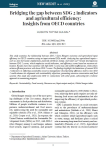Guldal H.T. (2025). Bridging the gap between SDG 2 indicators and agricultural efficiency: insights from OECD countries. New Medit, 01/09/2025, vol. 24, n. 4, p. 3-18.
https://doi.org/10.30682/nm2504a
https://doi.org/10.30682/nm2504a
| Titre : | Bridging the gap between SDG 2 indicators and agricultural efficiency: insights from OECD countries (2025) |
| Auteurs : | H.T. Guldal |
| Type de document : | Article |
| Dans : | New Medit (vol. 24, n. 4, September 2025) |
| Article en page(s) : | p. 3-18 |
| Langues : | Anglais |
| Langues du résumé : | Anglais |
| Catégories : |
Catégories principales 06 - AGRICULTURE. FORÊTS. PÊCHES ; 6.6 - Technique Agricole (sols, engrais, mécanisation)Thésaurus IAMM AGRICULTURE ; EFFICACITE ; MOYEN DE PRODUCTION AGRICOLE ; PRODUCTION AGRICOLE ; UNION EUROPEENNE |
| Résumé : | This study examines the relationship between SDG 2 (Zero Hunger) outcomes and agricultural input efficiency in OECD countries using an input-oriented DEA model. Analyzing key agricultural inputs- such as area harvested, employment, pesticide, fertilizer, energy, and water use-reveals discrepancies between SDG 2 scores, which emphasize social indicators, and efficiency scores based on resource utilization. Results show that countries with high SDG 2 scores may still exhibit inefficiencies, while others achieve efficient practices with lower SDG 2 scores. The findings highlight the limitations of current SDG 2 indicators in reflecting sustainable resource management. Incorporating efficiency metrics into SDG 2 could enhance its alignment with sustainability objectives, promoting resource conservation and food security. This study also underscores SDG 2s' connections with other goals, advocating for a holistic approach to measuring progress. |
| Cote : | En ligne |
| URL / DOI : | https://doi.org/10.30682/nm2504a |







